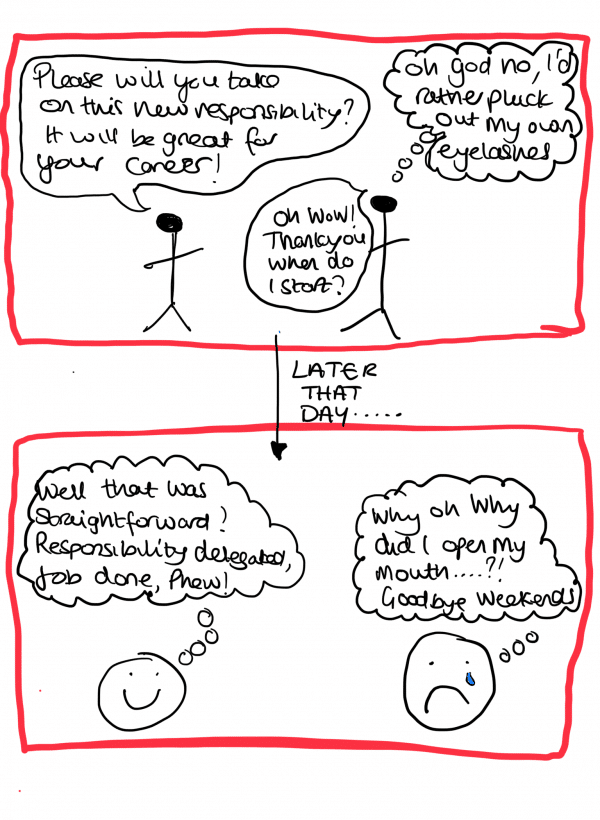‘No’ – such a little word, but so difficult to say
One of the things I hear most frequently in one-to-one coaching sessions with academic clients is ‘I need to say no more’. Whilst that it is easy to say and to know in theory, it is a whole lot harder to translate that into practice.
No is such a tiny word, but the reality is, it is often very hard to say! Why is that?! From my discussions with clients over the years it is evident that there are a variety of genuine reasons why ‘No’ does not come as an easy response to most of us. For example, even if we know we are already working at full capacity and should probably say no, we might be:
- worried that this will be the only opportunity that comes along
- genuinely interested in the opportunity
- flattered to be asked/invited
- concerned of negative career consequences if we say no
- worried about upsetting someone or letting someone down
- feeling obliged to do more for the CV
- unclear of the priorities/expectations for our role
- too rushed to be able to give it any thought
- wanting to be seen as a ‘good colleague’
- etc…..(add your own here!)
The result is that many of us fall into the trap of ‘default yes’ responses. You know the one, where internally you’re going ‘oh my goodness there’s no way I can fit this in, I’m already working above my allocated workload and I was hoping to actually take my holiday this year’ but in some kind of out-of-body moment you hear yourself saying the words ‘oh yes of course, that’s no problem, happy to help, when will you need it by?’ – we’ve all been there!

Let me be clear, I’m not saying you should never say yes again, definitely not. There will be opportunities you will need and want to say yes to. Of course, there will also be occasions where no is not an option (if you’re required to do something contractually, or for ethical/safety reasons for example). What I am saying though, for instances where you do have a choice, is to give yourself the opportunity to carefully consider which opportunities to say yes to and which to respectfully decline. If you’re naturally a ‘default yes’ person this is going to take some practice, but fear not – there’s a 3-step process you can go through to help you to make the shift from ‘default yes’ to ‘considered response’ each time.
Step 1. Clarify your priorities
Until you know where you’re heading it’s virtually impossible to select the most appropriate paths to get there. If you don’t have a sense of what your goals and priorities are it makes it very difficult to spot which opportunities to say yes or no to, i.e. which activities are going to help you towards your goals and which will distract you from them.
So, if you’re currently not clear on this, take some time to consider your future goals, what do you want to be working on in the coming months/years? What does ‘success’ mean for you? What would you be proud to say you’ve achieved in 5 years’ time? What are you not yet doing that you would like to start doing?
This is not always an easy process and can take some time, particularly if you’ve not done much forward planning before. Sometimes it’s helpful to talk this through with someone else such as a friend, colleague, mentor or coach (ok….shameless plug for our one-to-one coaching!). Giving yourself the space to consider your priorities will give you the best foundations for making decisions about what to get involved in and what to leave behind.
Step 2. When a request comes in….PAUSE
Ok, this is the crucial bit, and I’m making it bold because it’s so important. There is always a time period between a request and a response.
If you’re a ‘default yes’ person by nature, then it is likely that up until now you’ve not been making the most of this golden moment and the words might well be out of your mouth before you’ve even realised what’s happening!
However, to go from ‘default yes’ to ‘considered response’ it is important to maximise your use of the time between the request and response. You will likely need to buy yourself a bit more time to do this. I’m not talking about ages, but long enough to give yourself enough time to enact step 3 (see below).
Here are some ideas of how to buy yourself time to pause, if you’re usually a quick responder they will take some conscious practice before they become natural:
- If a request/opportunity comes in by email do not respond immediately (for many default yes people this might be uncomfortable), allow yourself a day or so to work through the 3 Cs (below) before sending your response. If you think you will need longer than 24-48 hours, you could send a holding email to say that you are giving it some consideration and to let them know when they can expect a response from you.
- If the request/opportunity comes in-person, it is always ok to ask for some time to think. This will indicate to the other person that you’re taking your consideration of the opportunity seriously. You could try something along the lines of:
- ‘Thanks for thinking of me for this, I’d like to have a careful think about it in relation to how it would fit with my existing commitments, I will get back to you by [Date].’ – make it your own by rehearsing it a few times so the next time you’re put on the spot this answer will roll off the tongue instead of ‘why, yes of course!’.
Step 3. Enact the ‘three Cs’
So you’ve successfully bought yourself some time, so now how do you make a careful decision about whether to say yes or no to a request or opportunity? Here’s where the three C’s come in, work through them in this order:
CLARIFY – Often when a request is put to you it might be a bit vague, the details might not have been well thought through yet, or there might not be enough information for you to know how much work is involved or what the expectations of you are. If this is the case it is important to go back to the ‘requester’ with some questions to clarify exactly what is being asked of you. Only once you have a very clear idea of what the request or opportunity is, and what your role is, should you move on to the next C….
CONSIDER – This is when you draw on the work you did in step 1 to identify your priorities. Consider this new opportunity in alignment with your priorities and existing commitments. If you take on this new opportunity is it going to help you towards your goals? Do you want to take it on? How will it fit around the other responsibilities you have? If you take it on will you need to drop something else? If so, what will you give up to enable you to take on the new opportunity? Is it worth it? Are there things you would need to negotiate first?
COMMUNICATE – The final step is to carefully construct your response. Only do this once you’ve worked through the first two C’s. Sometimes this will be a straightforward (but well considered) yes, sign me up! Other times though it might one of a whole variety of possible responses such as:
- A ‘Yes, but’ response, for example ‘I’d like to be involved, but not to the extent proposed – can we negotiate a different level of involvement?’ or ‘I’d like to do this, but I can’t commit to the proposed timeframes, I would need to be able to negotiate a later deadline’
- A ‘Yes, if’ response, for example, ‘Yes this sounds good, if we could also bring a collaborator on board to spread the expertise’
- A ‘Not yet’ response, for example, ‘This sounds like a great opportunity, but it’s not for me this time round as I’m already committed elsewhere. Please do keep me in mind for the future and get in touch if similar opportunities arise’
- A ‘No but’ response, for example ‘This sounds interesting, but it’s outside of my priority research areas so I will need to decline. However, this would likely be of interest to [colleague] who I know is working on these topics’
- A straightforward ‘No’ for example, ‘Thank you for thinking of me for this opportunity. However, it’s not the right fit for me and I will need to decline.’
Whatever you decide to communicate, keep it clear, concise and unapologetic. If you are declining you don’t need to offer lots of reasons and excuses, you are within your rights to say no (assuming it’s not a contractual obligation) and people will likely respect you for being clear of your priorities and being careful about what you commit to. If you’re a ‘default yes’ person by nature, it will take some practice and is likely to feel uncomfortable and scary to begin with. However, by becoming a ‘considered responder’ you will quickly start to reap the benefits of proactively deciding what to take on and what to leave behind.
We’re here to help! If you would like support with the topics covered in this blog post or any aspect of your research/academic role please contact us or visit researchcoach.co.uk to find out more about our services for academics and researchers. To keep up to date with our blogs, events, resources and opportunities please join the Research Coach mailing list







